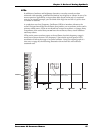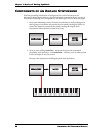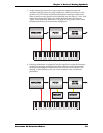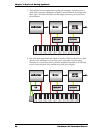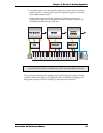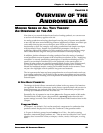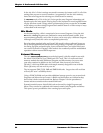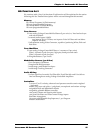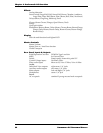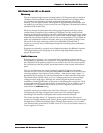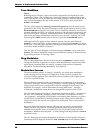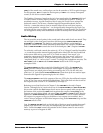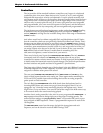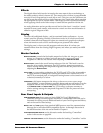
Chapter 4: Andromeda A6 Overview
94 ANDROMEDA A6 REFERENCE MANUAL
In the A6, all of a Voice’s settings are stored in memory for instant recall. So, all of the
settings that you use to create a sound are “programmed” into the A6’s memory,
hence the term Program for referring to a sound stored in memory.
In
PROGRAM mode, all 16 of the A6’s Voices get the same Program information and
therefore play the same sound. Playing keys on the keyboard or receiving MIDI notes
all play the same sound. Things start to get interesting when you put the A6 into
MIX
mode where you take existing Programs and combine them in a wide variety of ways
as described in the next topic.
Mix Mode
As the name implies, a Mix is comprised of two or more Programs. Using the A6’s
MIX mode, existing Programs are combined to create multi-textured sounds. In its
most extreme application, each of the 16 voices can be set to play a different Program.
Although rarely used, this can be accomplished quite easily.
But what about standard splits and layers? Mix mode is where splits and layers are
set up and programmed for instant recall using existing Programs. The procedures
for setting up splits and multi-splits, layers and multi-layers, and splits-with-layers
are covered in detail in Chapter 6. Mix mode is also commonly used for multitimbral
operation with an external MIDI sequencer.
External Memory
The A6’s RAM EXPANSION CARD port on the back panel is ideally suited for use with
the Alesis 512k PCMCIA Type I RAM card (PC Card). This is a credit-card-sized
memory module that adds additional Program and Mix memory for you to store
your own creations in addition to the User bank. Note, however, that Alesis
QCards™, which are ROM cards with sample memory designed for use with the
Alesis QS series, will not work in your A6.
The A6 supports 256K, 512K, 1MB and 2MB RAM cards. Larger sizes will work but
will only be “seen” as 2MB by the A6.
Using a PCMCIA RAM card provides additional storage space for you to store both
Programs and Mixes that you create. A RAM card also makes an excellent backup
device that is both convenient and fast. Refer to Chapter 2 for the procedure to
format and store sounds on the external RAM card.
External sounds from an Alesis RAM card can be used for single Programs and
Mixes. They can also be combined with internal sounds, both Programs and Mixes.
This opens up new possibilities when creating layers and splits.




